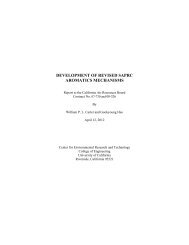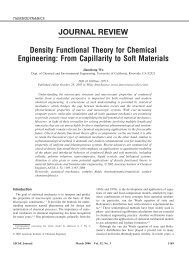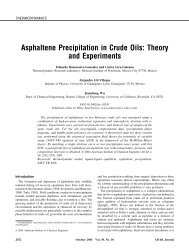Gas-Phase Ozone Oxidation of Monoterpenes: Gaseous and ...
Gas-Phase Ozone Oxidation of Monoterpenes: Gaseous and ...
Gas-Phase Ozone Oxidation of Monoterpenes: Gaseous and ...
You also want an ePaper? Increase the reach of your titles
YUMPU automatically turns print PDFs into web optimized ePapers that Google loves.
GAS-PHASE OZONE OXIDATION OF MONOTERPENES 255<br />
Figure 17. Reaction mechanism <strong>of</strong> O 3 / 3 -carene reaction.<br />
In addition to expected products, a number <strong>of</strong> products having minor yields that<br />
are unique to each monoterpene have also been detected. One interesting finding<br />
that is yet to be explained is the presence <strong>of</strong> pinic acid in both the sabinene/O 3 <strong>and</strong><br />
3 -carene/O 3 reactions.<br />
Yields <strong>of</strong> individual products in both the gas <strong>and</strong> aerosol phases have been<br />
determined or estimated, thus providing a direct measure <strong>of</strong> the gas-particle partitioning<br />
<strong>of</strong> each product. The identified products account for a significant fraction<br />
<strong>of</strong> the secondary organic aerosol for each <strong>of</strong> the parent hydrocarbons. Identified<br />
products, in both gas <strong>and</strong> aerosol phases, are estimated to account for about 34–<br />
50%, 57%, 29–67%, <strong>and</strong> 24% <strong>of</strong> the total reacted carbon mass for β-pinene,<br />
sabinene, α-pinene, <strong>and</strong> 3 -carene, respectively. Whereas these percentages exceed<br />
those <strong>of</strong> previous studies, a significant fraction <strong>of</strong> the monoterpenes reacted<br />
still remains unaccounted for. As the yields <strong>of</strong> many products are estimated using<br />
the response factor <strong>of</strong> surrogates, an improved mass balance awaits authentic st<strong>and</strong>ards<br />
or new analytical techniques that do not require authentic st<strong>and</strong>ards. Based on<br />
experimentally measured gas-particle partitioning coefficients <strong>of</strong> individual oxidation<br />
products, it is possible to evaluate the extent to which overall aerosol yields<br />
observed in smog chamber experiments can be represented by the stoichiometric<br />
yields <strong>and</strong> gas-particle partitioning <strong>of</strong> the individual products.<br />
Based on the nature <strong>and</strong> yield <strong>of</strong> various aerosol components, products such<br />
as pinic acid, pinonic acid, norpinonic acid, hydroxy pinonic acid, <strong>and</strong> hydroxy
















